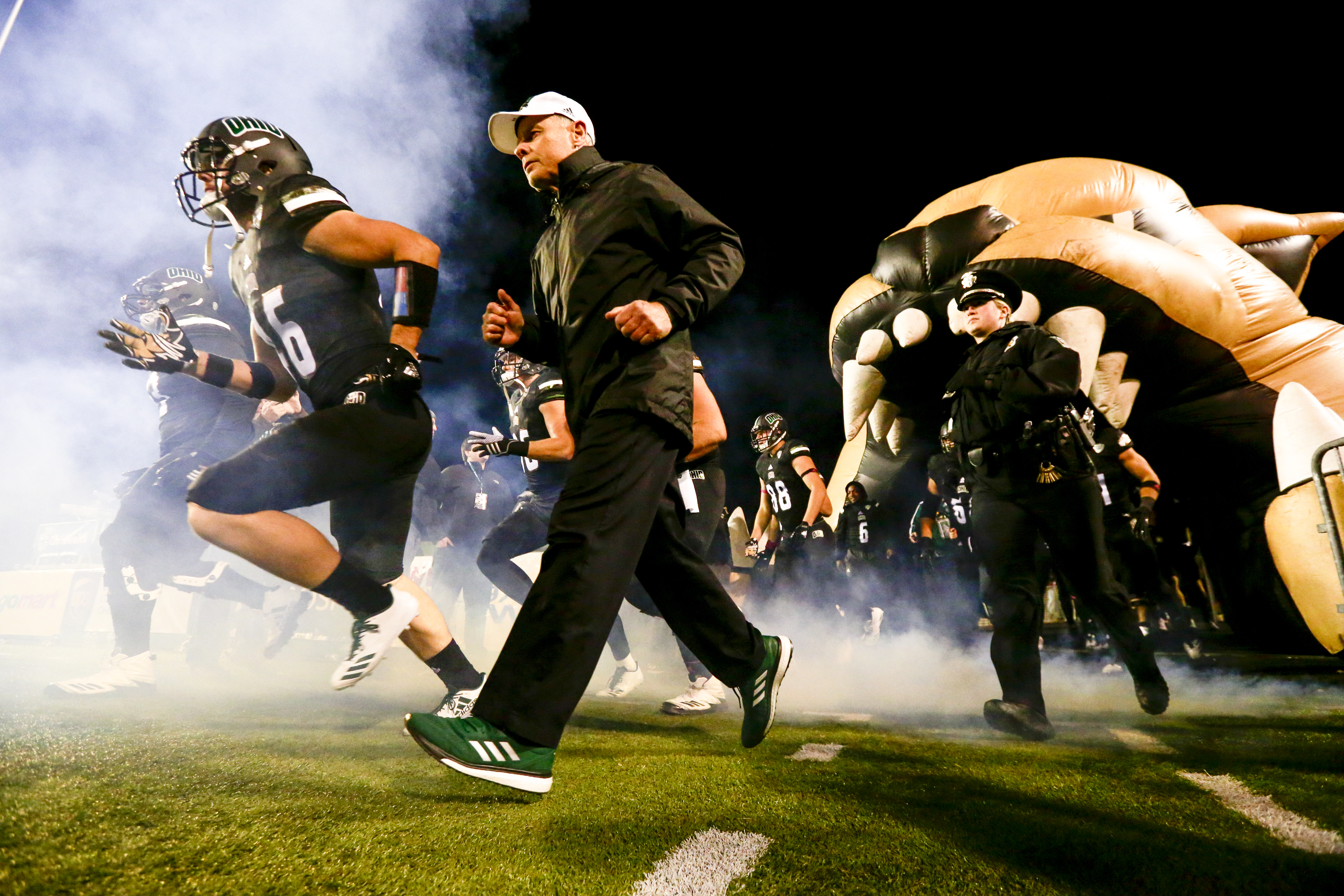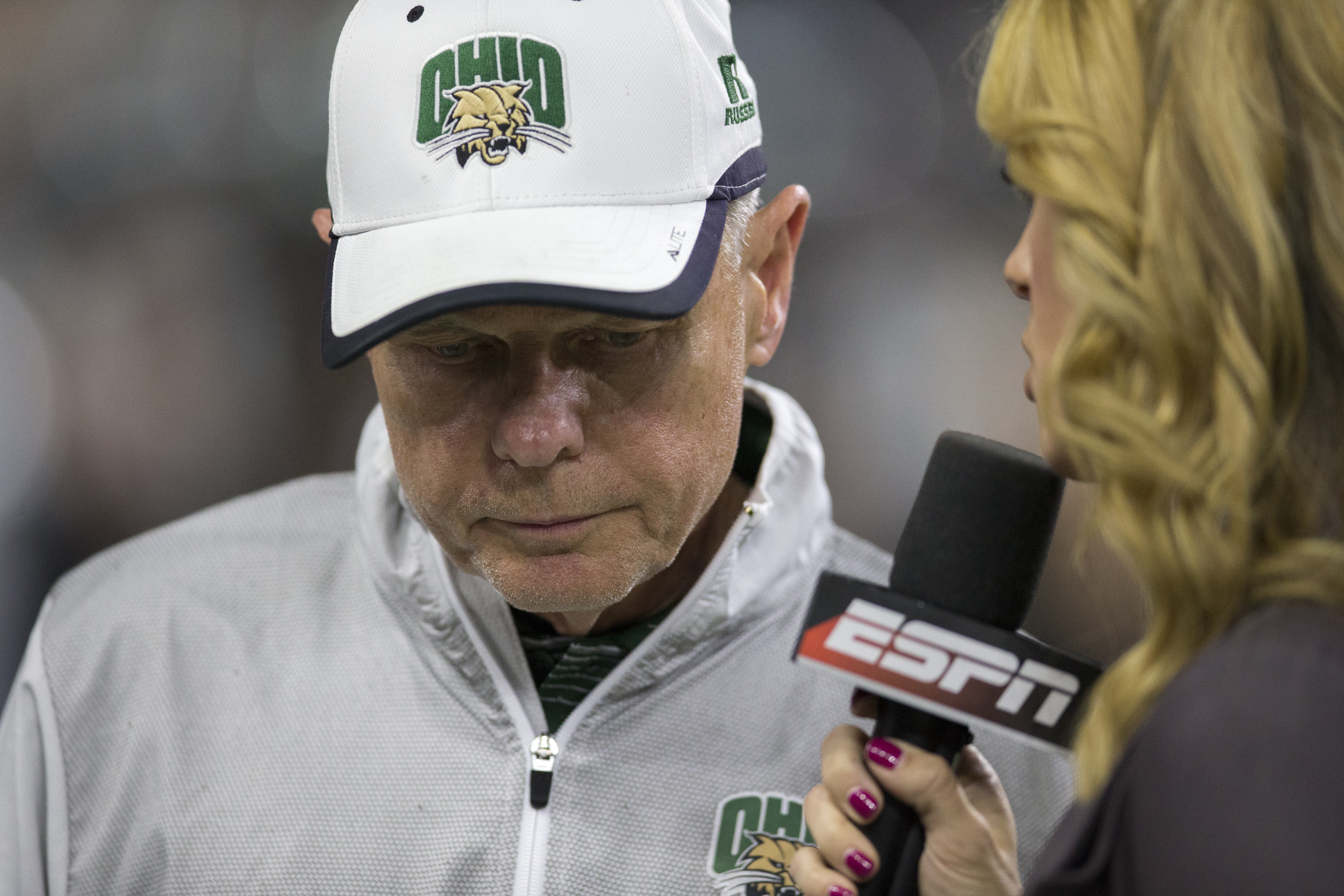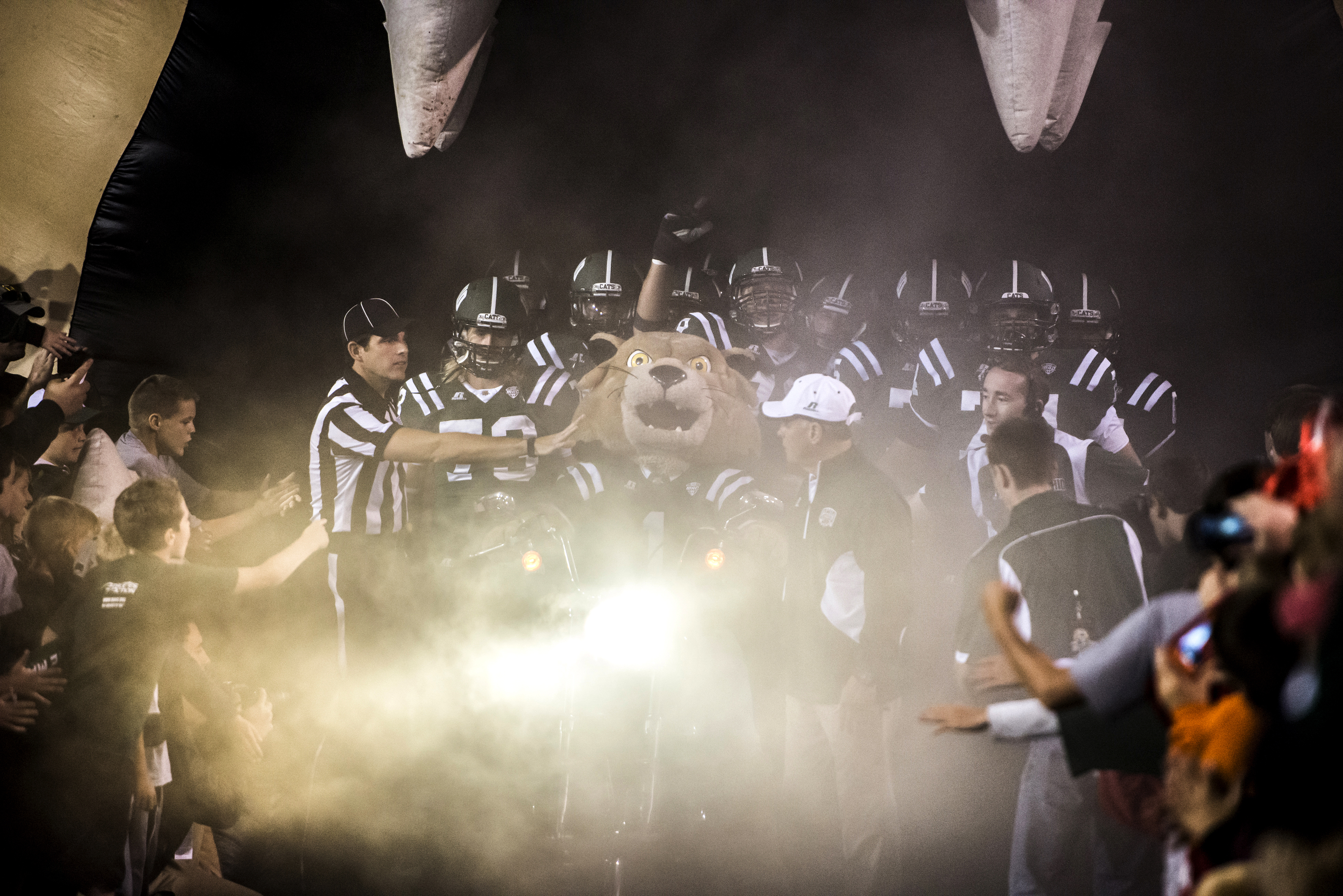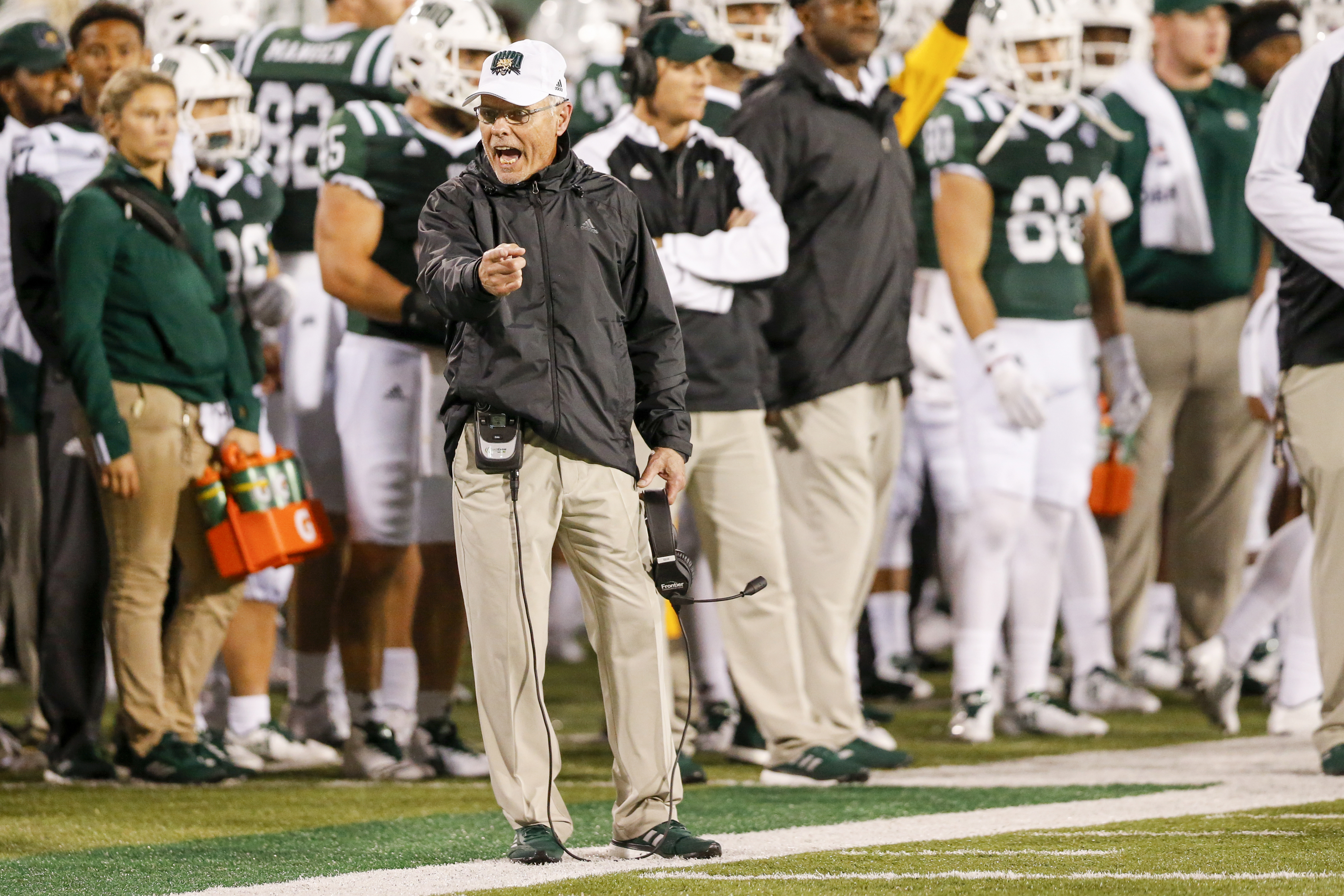Landing Page
Special Projects
This story is part of a series of specially designed stories that represents some of the best journalism The Post has to offer. Check out the rest of the special projects here.


CARL FONTICELLA
02.09.18

CARL FONTICELLA | FILE
Ohio head coach Frank Solich talks to an ESPN reporter before the start of the third quarter of the 2016 MAC Championship game at Ford Field in Detroit.
Mary Lyn Wininger just happened to be walking down a hallway when she heard him speaking.
Wininger, the former football secretary at the University of Nebraska-Lincoln, heard Frank Solich addressing the Cornhuskers one last time.
Nebraska finished a 9-3 regular season with a win at Colorado on Nov. 28, 2003. Just a day later, Nebraska athletic director Steve Pederson fired Solich as the head football coach.
Wininger heard Solich’s final speech to the program that he’d been a part of for 40 years. Wininger, still brought to tears talking about that day, said it’s something she’ll never forget.
“He was a man about it — talked to the team and said, ‘You have another win in you in the bowl game, and I want you to go and win the game. Make it a 10-3 season,’” Wininger recalled. “For him to go in and give them a pep talk after he was let go ... It made me respect him even more.”
With a record of 58-19 as head coach, Solich’s firing left some around Nebraska perplexed, saddened and angry. It’s still up for debate to this day at the mere mention of the name “Solich” to a Cornhuskers fan.
But as the controversy of his firing raged on, Solich took a year off from the game. He studied both NFL and college teams for a return to the sidelines. Just more than a year later, he found his return in a small town in Southeastern Ohio, a far trip from his former home in Lincoln, Nebraska.
Under Solich’s 13-year command, Ohio has become one of the most respected football teams in mid-major football. The Bobcats have played in nine bowl games under Solich and have been bowl eligible 11 times over the last 13 seasons. Solich is tied for the third longest-tenured coach in the FBS, the longest in the Group of Five.
The Bobcats were once known as a team that couldn’t reach bowl eligibility if wins are stacked from multiple seasons. Over the last 13 years, however, they’ve evolved into a constant threat to win the conference championship. Now, they’re a threat to win each and every game they play.
At 73 years old, Solich, who declined a sit-down interview for this story, has never been mentioned as a candidate to leave Ohio for greener pastures. Rarely mired in controversy, almost never viewed in a negative light.
And whatever feelings he had left over from his last speech to his old team, he let them out in his first meeting to his new one. Where one part of his career ended in Lincoln, another started in January 2005 at Walter Hall.
“After hearing him speak, you could just hear it in his voice,” former Ohio running back Kalvin McRae said. “He was determined to get us turned around.”
Andrew Stout couldn’t have been more confused.
College Bookstore was busier than ever, but, on that day, Stout wasn’t shipping merchandise throughout the state of Ohio. Instead, he was sending gear out to Nebraska.
Stout, the assistant general manager of the Court Street store, figured the men’s basketball team was playing in a tournament in Nebraska in mid-December. But eventually, he received a call much like ones he had gotten so many times that day. The shipping location was to Lincoln.
Stout had to ask why so much gear was being sent to a state with few ties to Ohio. After a brief pause, the customer’s answer was direct as possible.
“You hired our coach, dummy.”
But that call wasn’t the end of the orders by any means. Stout, who created the “Got Frank?” marketing campaign, watched as merchandise kept coming.
“There was a large contingent of people in Nebraska that felt that Frank got a raw deal,” Stout said. “I don’t suppose those fans are necessarily Bobcat fans — they’re Frank Solich fans.”
McRae saw the news on ESPN the night Solich’s hiring was announced. Former quarterback Austen Everson got a call from Gerry Gdowski, his new quarterbacks coach. But no matter how the team and community heard, they all were excited at the prospect of having an established and respected coach.
The Bobcats, away for winter break, didn’t meet Solich until winter quarter started. And that first meeting re-affirmed whatever the players thought about the new coach.
“You don’t want to be overly dramatic, but I honestly don’t know where you were going to find someone else with his ability and track record and, in all honesty, availability for a program that was in a position where the budget was limited,” former Ohio play-by-play broadcaster Derek Scott said.
If Solich was going to go 9-3 as a Bobcat, then he certainly wouldn’t be fired for it.
Ohio had its moments in previous years, yet there was no consistency. Now-former NFL wide receiver Antwaan Randle El was “ticketed” for Athens until Bob Knight offered him a chance to play basketball at Indiana. Now-former NFL safety and national champion Donnie Nickey looked like he’d play in the green and white, too, until Ohio State offered a scholarship at the last-second.
Ohio wanted a closer, and Solich had the fastball that the Bobcats so desperately needed.
“Coach Solich is a pretty demanding coach. He doesn’t oftentimes ever get outworked in terms of his approach to the game,” Everson said. “I think his expectations of us were kind of ramped up for us.”
And throughout the first summer, expectations ramped up like no one in Athens had experienced. Even with an opening loss to Northwestern to start the Solich era, the stage was set for one of the biggest games Peden Stadium had ever seen.

CARL FONTICELLA | FILE
Frank Solich prepares to lead the Bobcats onto the field before the start of the rivalry game against Marshall on September 14, 2013.
On Sept. 9, 2005, Pittsburgh came to Athens for the first home game of the Solich tenure. The game was on national TV and was played before a record crowd of 24,545. The entirety of the stadium built in 1929 was rocking, and even Pitt knew trouble was brewing.
“I knew (then-Pitt head coach) Dave (Wannstedt) a long time,” former Mid-American Conference Commissioner Rick Chryst said. “So I see him on the field before the game and he goes ‘Oh, this is great.’ Like he sort of knew what might be coming.”
The beginning wasn’t great for Ohio though: Pittsburgh housed the opening kick for a score. But then, the Bobcats took hold on defense, led by cornerback Dion Byrum, who ran an interception back for a touchdown in regulation.
Then in overtime, Pitt quarterback Tyler Palko threw a curl route on 3rd and 4. Byrum jumped that, too.
Byrum had told McRae the week prior that Palko liked to throw on three-step drops. He also told McRae that he’d jump those routes if he saw them. Byrum did just that and raced down the left sideline with the OU student section, and some players, right behind him.
“Everytime I watch highlights of that game, I probably could’ve gotten a penalty because I’m like almost at the numbers on the field while Dion is running,” McRae said with a laugh. “Thank God they didn’t throw a flag.”
Byrum stopped just a yard into the end zone and placed the ball down, ending one of the most memorable games in Bobcats history.
“When we were first here, we were told our first goal was to keep people from leaving after the band played at halftime,” defensive coordinator Jimmy Burrow said. “The band is awesome, but they weren’t leaving after the Pittsburgh game at half.”
The entire student section poured onto the field — and later onto streets throughout Athens — to celebrate the Bobcats’ win.
“We were sitting on our front porch with our buddies, our friends, some family around,” Everson said. “A couch was being pulled in a pickup truck behind us lit on fire, and they pushed it out in the road out in front of our house on High Street.”
Ohio football had arrived, couches on fire or otherwise. The team finished just 4-7, but the program was clearly moving in a positive direction. For a team that needed any kind of positivity, it was a welcomed sight. No one expected even a bowl game at the outset, but a win over a notable team was more excitement than the team had seen in decades.
For the last quarter of the 20th century, Nebraska football displayed an era of dominance unmatched in college football history. To say the Cornhuskers dominated their opponents would be putting it lightly.
The Cornhuskers winning percentage over those decades was 85 percent en route to nine bowl wins. They were known for their powering running game, with names such as Roger Craig, Mike Rozier, Lawrence Phillips and Ahman Green. Rozier is a member of the College Football Hall of Fame and won the Heisman Trophy in 1983.
And Solich coached running backs.
“I remember playing those teams all too well,” said Kirby Hocutt, a linebacker for Kansas State from 1991-94 who later became Ohio’s athletic director. “They were a very physical team to play that would try to dominate you at the line of scrimmage.”
Solich was recruited by Bob Devaney, who won two national championships and is a member of the College Football Hall of Fame, in 1963 to play fullback at Nebraska.
Solich earned the nickname “Fearless Frankie” for his playing style and even graced the cover of Sports Illustrated in 1965.
In Osborne’s patented option offense, Solich’s running backs routinely ran free. Five of Nebraska’s all-time leading rushers played with Solich as the running backs coach or as the head coach.
That success has continued throughout his entire career, stretching from his time in Lincoln to his time in Athens.
“I still remember him looking inside and saying, ‘You don’t have to break 50-yard runs every play,’” McRae, Ohio’s all-time leading rusher, recalled. “‘Stay within the game and if everything works itself out, in the fourth quarter, those six-yard plays turn into 20-yard plays.’ He taught me to run within the system and be patient as a runner.”
It’s one of the reasons for the success Ohio has had, too. It’s not just a product of a one-time system or a senior-laden offensive line and running back.
This past season, Ohio averaged 244.5 yards per game on the ground and put up 44 rushing touchdowns, both best in the MAC. Four starters on the offensive line will return in the 2018 season, as will starting quarterback Nathan Rourke and running back A.J. Ouellette.
Because of that, Solich’s roots as a runner, both as a coach and a player, haven’t been forgotten by following generations. Ouellette, born just over a month after Nebraska’s second national title in 1995, took note.
Ouellete also wears Solich’s old No. 45, a not-so-subtle nod to Solich’s opinion of Ouellette.
Ouellette asked Matt Morton, the assistant athletic director of equipment, about the number and the reason he was given No. 45 — a number he didn’t originally ask for. Morton didn’t say anything, and instead only gave a quick smile and a wink.
“Once I started looking into Ohio, I noticed that the running backs that came from here were really good,” Ouellette said. “Coach Solich being the stud running back he was, it kind of puts a smile on a running back’s face when his head coach is a running back.”
Solich was hired twice in his life as a head coach. And to those involved in the situations, both were unlike any other hirings they’d ever seen.
At Nebraska, Solich had to replace Osborne, one of the greatest coaches in college football history — he left the Cornhuskers with an all-time record of 255-49-3.
“Coach Solich being able to coach right after coach Osborne, to do the job that he did, I think that all kind of signifies how good of a head coach he is,” said Turner Gill, a former Nebraska assistant and current Liberty coach.
The goal, however, was as clear as it was daunting: Solich had to replicate that level of success. It was expected.
“Everybody has their own different personality,” Gill said. “Coach Solich didn’t speak a whole lot, per se. Coach Osborne, the same way — but when they spoke, people listened.”
In Athens, the fact that the former Nebraska head coach was in town was enough for excitement in its own right. But he proved that he wasn’t in it for just a job interview — he was serious.
“He had come down Friday and had driven down to Athens to look at Peden Stadium and to just get a feel for Athens. That greatly impressed all of us,” then-OU President Roderick McDavis said.
The other two final candidates for the job opening were then-Florida defensive coordinator Charlie Strong and then-Maryland offensive coordinator Charlie Taaffe. Strong, who never visited Athens, later went on to coach Louisville and Texas and is the current coach at South Florida. Taffe, who retired in 2014, made stops at Pittsburgh, UCF and the Canadian Football League after 2004.
But Solich, a native Ohioan, was the clear choice. When he accepted the job, he had his staff ready.
Tim Albin and Burrow, both at North Dakota State at the time, were named the offensive and defensive coordinators. Both remain at those positions to this day. Gdowski, now at Vanderbilt under the same title, would be named the quarterbacks coach. McDavis said he’d never seen anything like that before.
But Solich’s philosophy never changed. He had a plan, one that had delivered national championships in Lincoln.
“It was always one of the hardest games to game-plan against Frank Solich teams,” said P.J. Fleck, the former Western Michigan head coach, currently at Minnesota. “They were just gonna play so darn physical because they were such a blue-collar, hard-working team.”
Solich was at the controls for six years of Nebraska football, and he tried to keep the same level of consistency that had been put in place through decades of work. At the time, that was the only way of doing things. And to at least some extent, it worked.
He coached a Heisman Trophy winner, Eric Crouch, who won the award in 2001. That year, Nebraska lost to Miami (Fla.) in the national championship game. Crouch, who almost left the program due to questions about a position change, was a dual-threat quarterback who ran the option to perfection.
Years later, he still finds the time to watch his former coach at a different school. And when he does, one particular thing stands out to him.
“He just has this look on this face, like he’s actually ready to put the pads on and go run a touchdown,” Crouch said. “He’s (73) and he still looks the same way when I see him on TV. I don’t know anybody else that old that looks like that.”

CARL FONTICELLA | FILE
Ohio head coach Frank Solich makes sure the referee knows his feelings towards a call during the Bobcat's 59-0 win over Hampton on September 2 at Peden Stadium.
And in replacing a legend, Solich did an admirable job through the first four years — at least by Nebraska standards. After a 9-4 season in his first year as coach, he rolled off 12-, 10- and 11-win seasons. In 1999, he won his first, and only, conference championship as a head coach.
“That was one of the things that people were concerned about: how he would communicate with the players, how he would communicate with the other coaches,” Crouch said. “I thought he did a tremendous job.”
But suddenly, it looked like the Nebraska way wasn’t the way anymore.
Nebraska finished the 2002 season 7-7, which led to questions about Solich’s job security heading into the 2003 season.
“We knew that year was a year that we had to do some great things,” Gill said. “I guess myself as a person that is coaching, or non-coaching or whatever, to think that you would be fired after you win nine games, that was kind of surprising.”
The Cornhuskers began that season 5-0, but finished just 4-3 down the stretch. The losses weren’t close, either. But Nebraska beat Colorado 31-22 on the final day of the regular season, just a day after Thanksgiving.
Even 15 years later, when the phrase “Frank Solich fired” is searched on Twitter, it’s filled with Nebraska fans who claim that not having a plan was what doomed the program.
“Your school can have a bad year. If you ask (programs) if 9-3 was a bad year, they’re going to laugh at you. You’re going to get laughed at by most schools, maybe all of them. For whatever reason, I think that Steve Pederson had a different plan and Frank Solich wasn’t part of it. If Steve Pederson wouldn’t have been the athletic director, Frank Solich may still be at Nebraska.” - Eric Crouch, a 2001 Heisman Trophy winner
Others will say the firing was what damned them from the start. Either way, most will agree that it wasn’t handled well.
“I thought it was a very poor decision because, from a coach's standpoint, he had won 76 percent of his games, which puts him pretty much in the category of guys like Bear Bryant, Woody Hayes and Joe Paterno,” Osborne said.
Nebraska still had a bowl game to play, against Michigan in the Alamo Bowl. Solich, for the first time since 1978, wouldn’t be on the Nebraska sideline.
“Your school can have a bad year,” Crouch said. “If you ask (programs) if 9-3 was a bad year, they’re going to laugh at you. You’re going to get laughed at by most schools, maybe all of them. For whatever reason, I think that Steve Pederson had a different plan and Frank Solich wasn’t part of it. If Steve Pederson wouldn’t have been the athletic director, Frank Solich may still be at Nebraska.”
Bill Callahan was later named head coach at the beginning of 2004. Nebraska missed its first bowl game since 1968 in Callahan’s first season.
As for Solich, the home he’d known for 40 years was no more. But just a year and two weeks later, Solich was announced as Ohio’s next head coach.
“He’ll always be our coach,” Wininger said. “I think everybody feels that way. He’s our coach, we’re just letting you have him for a while.”
Solich and his staff then began to try and rebuild a program that hadn’t ever won a bowl game, a team that in its previous 34 seasons had reached the eight-win mark just once. It wouldn’t have been a stretch to call Ohio the worst football program in the country at the time. From 1977-2004, Ohio’s record was 95-164-6 — a winning percentage of just 35.8. In the previous three seasons, the Bobcats had won a combined seven games.
“I remember telling Frank at the time, ‘You win nine games at Ohio, we’ll have a parade for you,’” Hocutt said.
Solich and the Bobcats were flying as high as a four-win team could fly after 2005.
Ohio had a sense of direction that everyone knew would work, even if it didn’t come on the field at first. The players that committed were more highly rated, as players on the team reached new heights in the weight room. Everything seemed according to plan.
But for the first time in Solich’s career, trouble was ahead.
On Nov. 26, 2005, Solich was found passed out at the wheel of a vehicle on West Union Street. He had been at Casa Cantina, now Casa Nueva, and was convicted of a DUI on Nov. 28.
Solich originally pleaded guilty, but, in the following summer, Solich and his attorney attempted a plea-withdrawal. He and his attorney pled that Solich neither consumed the amount of alcohol it would have taken for him to pass out. Rather, they claimed he was slipped GHB, known as a “date rape” drug, and he was drugged, not drunk. A judge later refused to withdraw his no contest plea. Solich lost his license for six months and was fined. He was also put on probation by the university.
“All situations are unique, and the facts, I think you have to look at each situation individually,” Hocutt said. “It was the first misstep that he had made during his entire career. I know it was one that he wasn’t proud of ... but it was a first mistake that he’s made.”
Solich was allowed to keep his job and would remain the head football coach.
With the most troubling moment of his career behind him, Solich and the Bobcats began preparations for the 2006 season. And that 2006 season was the beginning of a remarkable decade-plus of success.
The Bobcats initially slipped to 2-3, but, after a players-only meeting led by McRae and other seniors, Ohio rallied and won its last seven games. The final win of the season ended a six-game losing streak to Miami.
Just three years after being fired for a 9-3 regular season, Solich led the 9-3 Bobcats into their first-ever MAC Championship Game. Ohio fell to Central Michigan, but a bowl game still awaited Ohio for the first time since 1968. No one on the roster was alive when the Bobcats last played in a bowl game.
“It was astounding to see it turn that quickly into something that took you to the postseason the way it did,” Scott said.
Despite a 28-7 loss to Southern Mississippi in the GMAC Bowl, the seeds of success were planted for the long-haul. Solich was, too.
Solich has won 97 games as head coach of the Bobcats, which puts him third in Ohio history and third in MAC history for wins by a head coach. The wins have been both mundane and remarkable, as wins against Austin Peay and Wofford have been forgotten for upset wins at Penn State and Illinois.
“I always say it’s the five best years of my life,” former quarterback Tyler Tettleton said. “He’s the main reason why. I think whenever he’s asked what that means to him, I think it means everything. That’s what he envisioned when he got there.”
Tettleton led the Bobcats to their first bowl victory in 2011, a 24-23 win over Utah State in the Idaho Potato Bowl. In Solich’s 13 seasons, Ohio has won three bowl games.
Solich’s consistency has been nothing short of remarkable, considering the MAC’s tendency to have short-term coaches jump for a Power Five job.
“(The Bobcats) have a hall-of-fame, legendary coach with incredible integrity and character,” Fleck said. “Never take that winning for granted.”
The one thing, however, that gnaws Bobcat players past and present to their core are the MAC Championship Games. More specifically, though, it’s the MAC Championship losses. Despite the four opponents boasting a combined 39-9 record entering the title game, the Bobcats have come agonizingly close multiple times never to win.
In 2016, Ohio fell 29-23 to unbeaten Western Michigan, coached by Fleck. The Bobcats threw an interception as they marched in Broncos territory as the game wound down. Ohio also fell 20-10 in 2009 and, after a fourth quarter that got away, 31-10 in 2006.
But the one that stings for Tettleton and so many others is the 2011 game, a 23-20 loss to Northern Illinois that is so much more excruciating than the score would indicate.
“To this day, I still think about that,” Tettleton said.
The Bobcats led 20-0 at halftime but allowed 16 points in the fourth quarter and lost on a last-second field goal.
“It just drives me crazy that we didn’t get that done,” Tettleton continued. “I know that’s what he’s been striving for, ever since he’s got there, to win a conference championship. It sucks. It drives me crazy to this day that we couldn’t get it done for him.”
It’s ironic, in a cruel sort of way, that one of the MAC’s most successful coaches in history has never come away with the conference’s top prize. But that still doesn’t diminish Solich’s story, or the impact he’s had on Ohio as a program and university.
“You think about those Nebraska teams, the consistency in the 1990s,” Hocutt said. “He’s brought the same type to Ohio University during his time there.”

CARL FONTICELLA | FILE
Ohio head coach Frank Solich walks down the sideline during the Bobcats' game against Gardner-Webb on Sept. 24, 2016.
As another season ends, jobs and coaching staffs change regularly. Awards are given out, and countdowns are made for kickoff in September. Football is cyclical in that way.
Yet through conference realignment, coaching changes and just about anything else thrown his way, Solich has been there. No matter the situation, he’s been steadfast. There have been no goodbye press conferences for anyone on Solich’s staff, nor an introductory presser for a new coach or coordinator.
Every year since 1963, with the exception of 2004, Solich has hit the field as a member of the Bobcats or the Cornhuskers. He’s been a consistent winner throughout his entire career at schools that couldn’t be farther on opposite ends of the spectrum.
“Coach (Steve) Spurrier would occasionally try and needle Nick Saban and say, ‘He’s great at Alabama, but I’d like to see him get it done somewhere other than Alabama and LSU where resources aren’t always so flush, ” Scott, now at South Carolina, said. “(Solich has) done it at a power conference, legendary program and he’s done it at a MAC school that had gone 40 years without a bowl trip.”
Instead, he’s always been there. It’s not mundane — it’s Frank Solich.
“He doesn’t value a stadium with 90, 100,000 people, he doesn’t value aluminum, he doesn’t value concrete, he doesn’t value grass,” Fleck said. “He values people. He values the relationships he can have with people. That’s what makes him Frank Solich.”
He’ll be around for his 14th season as a Bobcat come next fall, aiming to help Ohio capture its first MAC title in 50 years. It might be the year he leaves the game behind; it might not.
The only thing that can be known for sure is that Solich will pace the sidelines just like he has for the last 51 years.
“How he got there isn’t probably perfect in his eyes,” Everson said. “I know that he’s meant a lot to all of us that have played for him and changed a lot of lives along the way.”
“Coach (Steve) Spurrier would occasionally try and needle Nick Saban and say, ‘He’s great at Alabama, but I’d like to see him get it done somewhere other than Alabama and LSU where resources aren’t always so flush. (Solich has) done it at a power conference, legendary program and he’s done it at a MAC school that had gone 40 years without a bowl trip.” - Derek Scott, former Ohio play-by-play broadcaster“
But as Solich’s career in Athens continues, he still has his Nebraska roots intact.
Just a few years ago, Wininger called Solich to see if he was free for dinner. She had left her job in 2004, a year after Solich left Nebraska. Solich left Athens after practice to see Wininger once again, who was in Ohio for a trade show. Solich was as grateful as ever to accept the offer, and he drove to dinner. As the two caught up, Wininger was brought back to her days with the Nebraska program, a time when Solich and the Cornhuskers were the class of college football.
When Osborne took members of the athletic department at Nebraska out to dinner, people often came up to meet and say hello to one of college football’s best coaches. It happened to Solich, too.
“That just made me feel good, that he was getting the respect that he deserved,” Wininger said.
It’s those roots, though, that have allowed him to succeed. It’s in Athens where he’s created a vision, played out in green and white against Akron and Buffalo instead of in red and white against Texas and Oklahoma.
The teams, however, are irrelevant.
It wasn’t what most envisioned for Solich, the lifelong Cornhusker, before his time in Athens. But to the Bobcats, there has never been a coach or person more influential to the program.
“It’s just something that everybody there should be incredibly thankful for, that it has worked out the way it has,” Scott said. “To get a dozen years plus with a guy of his abilities and credibilities is just, boy, I tell you, it’s pretty amazing.”
Landing Page
This story is part of a series of specially designed stories that represents some of the best journalism The Post has to offer. Check out the rest of the special projects here.